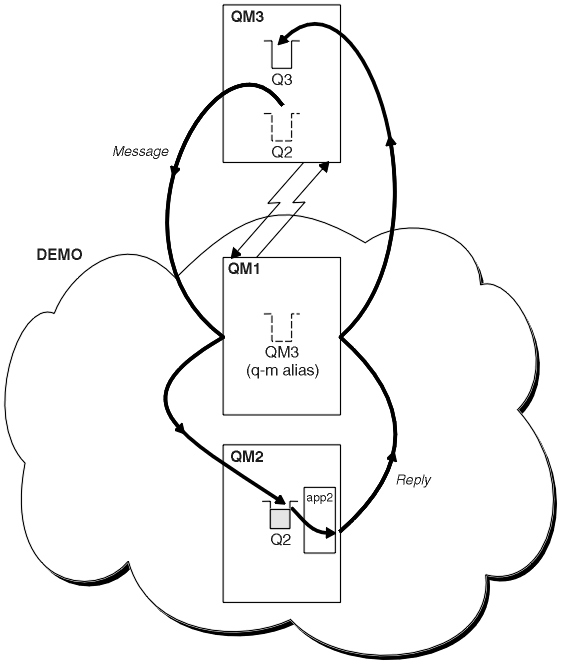Configure request/reply to a cluster
Configure a request/reply message path from a queue manager outside a cluster. Hide the inner details of the cluster by using a gateway queue manager as the communication path to and from the cluster.
Before you begin
Figure 1 shows a queue manager called QM3 that is outside the cluster called DEMO. QM3 could be a queue manager on an IBM MQ product that does not support clusters. QM3 hosts a queue called Q3, which is defined as follows:DEFINE QLOCAL(Q3)Inside the cluster are two queue managers called QM1 and QM2. QM2 hosts a cluster queue called Q2, which is defined as follows:
DEFINE QLOCAL(Q2) CLUSTER(DEMO)

Follow the advice in the procedure to set up the path for the request and reply messages.
Procedure
-
Send the request message to the cluster.
Consider how the queue manager that is outside the cluster puts a message to the queue Q2 at QM2, that is inside the cluster. A queue manager outside the cluster must have a QREMOTE definition for each queue in the cluster that it puts messages to.
-
Define a remote queue for Q2 on QM3.
DEFINE QREMOTE(Q2) RNAME(Q2) RQMNAME(QM2) XMITQ(QM1)
Because QM3 is not part of a cluster, it must communicate using distributed queuing techniques. Therefore, it must also have a sender-channel and a transmission queue to QM1. QM1 needs a corresponding receiver channel. The channels and transmission queues are not shown explicitly in Figure 1.
In the example, an application at QM3 issues an MQPUT call to put a message to Q2. The QREMOTE definition causes the message to be routed to Q2 at QM2 using the sender-channel that is getting messages from the QM1 transmission queue.
-
Define a remote queue for Q2 on QM3.
-
Receive the reply message from the cluster.
Use a queue manager alias to create a return path for replies to a queue manager outside the cluster. The gateway, QM1, advertises a queue manager alias for the queue manager that is outside the cluster, QM3. It advertises QM3 to the queue managers inside the cluster by adding the cluster attribute to a queue manager alias definition for QM3. A queue manager alias definition is like a remote queue definition, but with a blank RNAME.
-
Define a queue manager alias for QM3 on QM1.
DEFINE QREMOTE(QM3) RNAME(' ') RQMNAME(QM3) CLUSTER(DEMO)We must consider the choice of name for the transmission queue used to forward replies back from QM1 to QM3. Implicit in the QREMOTE definition, by the omission of the XMITQ attribute, is the name of the transmission queue is QM3. But QM3 is the same name as we expect to advertise to the rest of the cluster using the queue manager alias. IBM MQ does not allow you to give both the transmission queue and the queue manager alias the same name. One solution is to create a transmission queue to forward messages to QM3 with a different name to the queue manager alias.
-
Provide the transmission queue name in the QREMOTE definition.
DEFINE QREMOTE(QM3) RNAME(' ') RQMNAME(QM3) CLUSTER(DEMO) XMITQ(QM3.XMIT)The new queue manager alias couples the new transmission queue called QM3.XMIT with the QM3 queue manager alias. It is a simple and correct solution, but not wholly satisfactory. It has broken the naming convention for transmission queues that they are given the same name as the target queue manager. Are there any alternative solutions that preserve the transmission queue naming convention?
The problem arises because the requester defaulted to passing QM3 as the reply-to queue manager name in the request message that is sent from QM3. The server on QM2 uses the QM3 reply-to queue manager name to address QM3 in its replies. The solution required QM1 to advertise QM3 as the queue manager alias to return reply messages to and prevented QM1 from using QM3 as the name of the transmission queue.
Instead of defaulting to providing QM3 as the reply-to queue manager name, applications on QM3 need to pass a reply-to queue manager alias to QM1 for reply messages. The gateway queue manager QM1 advertises the queue manager alias for replies to QM3 rather than QM3 itself, avoiding the conflict with the name of the transmission queue.
-
Define a queue manager alias for QM3 on QM1.
DEFINE QREMOTE(QM3.ALIAS) RNAME(' ') RQMNAME(QM3) CLUSTER(DEMO)Two changes to the configuration commands are required.- The QREMOTE at QM1 now advertises our queue manager alias QM3.ALIAS to the rest of the cluster, coupling it to the name of the real queue manager QM3. QM3 is again the name of the transmission queue to send reply queues back to QM3
- The client application must provide QM3.ALIAS as the name of the reply-to queue manager when it constructs the request message. We can provide QM3.ALIAS to the client application in one of two ways.
- Code QM3.ALIAS in the reply-to queue manager name field constructed by MQPUT in the MQMD. You must do it this way if you are using a dynamic queue for replies.
- Use a reply-to queue alias, Q3.ALIAS, rather than a reply-to queue when providing the reply-to queue name.
DEFINE QREMOTE(Q3.ALIAS) RNAME(Q3) RQMNAME(QM3.ALIAS)
-
Define a queue manager alias for QM3 on QM1.
What to do next
Note: We cannot demonstrate the use of reply-to queue aliases with AMQSREQ0. It opens the reply-to queue using the queue name provided in parameter 3, or the default SYSTEM.SAMPLE.REPLY model queue. You need to modify the sample providing another parameter containing the reply-to queue alias to name the reply-to queue manager alias for MQPUT.